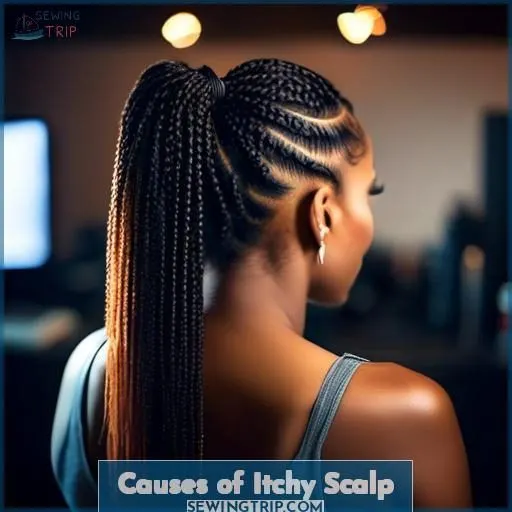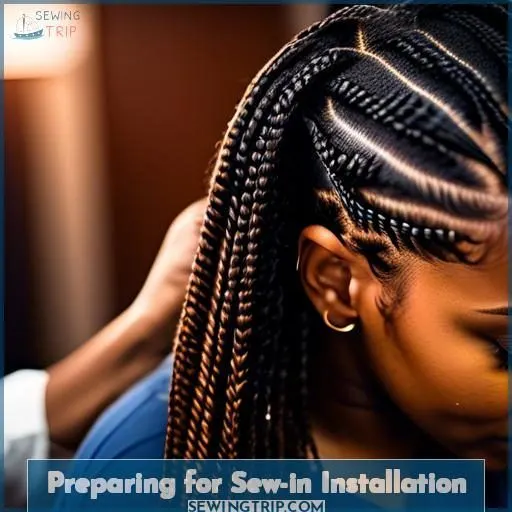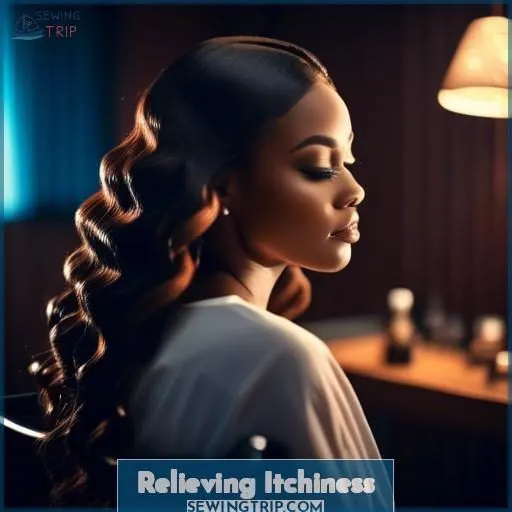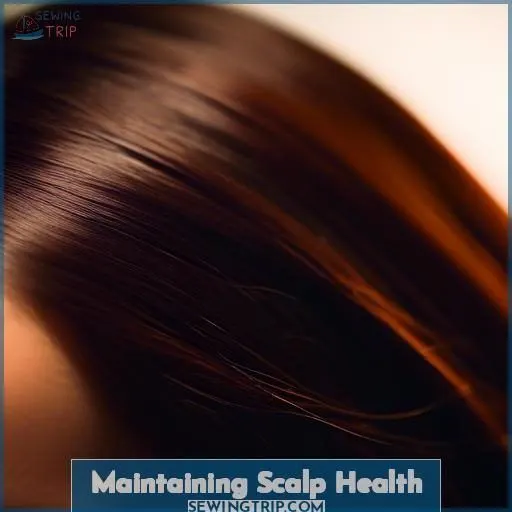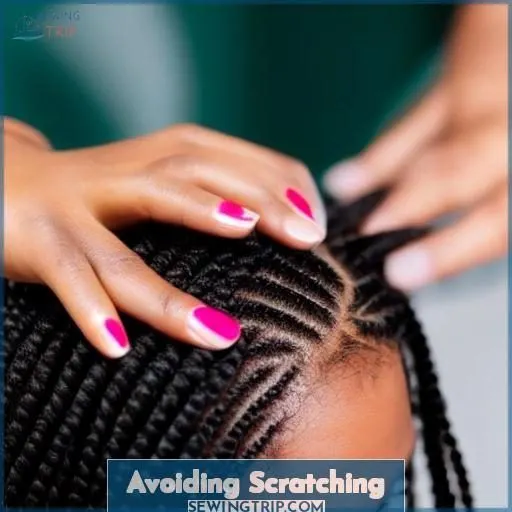This site is supported by our readers. We may earn a commission, at no cost to you, if you purchase through links.
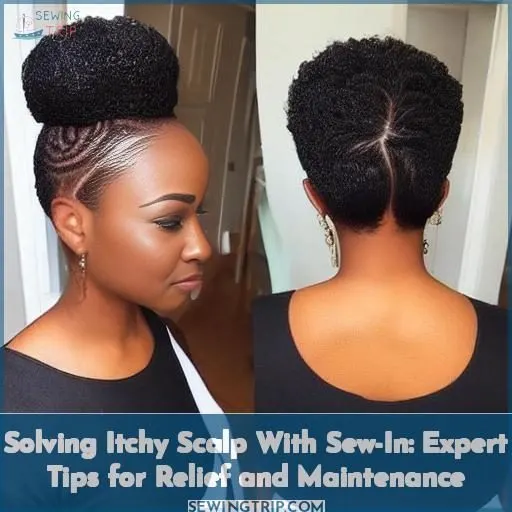
If you’re struggling with an itchy scalp from your sew-in, there are effective solutions to find relief. First, properly prepare your scalp before the installation by cleansing, hydrating, and applying soothing oils.
During wear, use a dry shampoo and diluted apple cider vinegar rinse to keep your scalp clean and balanced. Avoid excessive scratching, which can worsen irritation.
For long-term management, utilize scalp soothers, scratchers, and massage tools to maintain a healthy scalp. By taking a proactive approach, you can effectively cure an itchy scalp and enjoy your sew-in with confidence. Read on to discover more expert tips for managing scalp health.
Table Of Contents
Key Takeaways
- Properly prepare your scalp before a sew-in installation by cleansing, hydrating, and applying soothing oils.
- During wear, use a dry shampoo and diluted apple cider vinegar rinse to keep your scalp clean and balanced.
- For long-term management, utilize scalp soothers, scratchers, and massage tools to maintain a healthy scalp.
- Causes of an itchy scalp can range from dandruff and dermatitis to scalp psoriasis, and can be managed with targeted solutions.
How to Cure Itchy Scalp With Sew In?
To cure an itchy scalp with a sew-in, follow these expert tips:
- Moisturize your scalp: Apply a moisturizing product like oil to your scalp before your appointment to prevent dryness and itching.
- Loosen your braids: Tight braids can stretch your scalp, causing irritation and itching. Ask your stylist to loosen them up.
- Use natural hair extensions: Artificial hair extensions made of synthetic fibers have an alkaline coating, which can cause an allergic reaction. Using 100% human hair can help you avoid skin irritation.
- Wash your sew-in: The frequency of washing your hair depends on your hair type. Straight hair needs to be washed 2-3 times a week, while curly and wavy hair needs to be washed once a week.
- Change out your sew-in regularly: Avoid keeping the same weave on for more than 2 months. Keeping extensions in longer can’t only cause itching but can also increase your risk of infection.
- Use a sulfate-free shampoo: Cleanse your scalp with a sulfate-free shampoo to prevent the buildup of oils, dirt, and sweat that can contribute to itchiness.
- Diluted Apple Cider Vinegar Rinse: Mix equal parts of apple cider vinegar and water, apply the mixture to your scalp, and rinse it out after a few minutes. Apple cider vinegar has natural antifungal and antibacterial properties that can help soothe an itchy scalp.
- Avoid scratching: Scratching your scalp can make the itchiness worse and potentially damage your sew-in weave. Instead, gently pat or massage your scalp to relieve itch.
- Maintain proper hydration: Drinking enough water and maintaining overall hydration can help keep your scalp and skin healthy, which can relieve itchiness.
- Avoid heavy products: Opt for lightweight products that won’t clog your hair follicles and contribute to buildup on the scalp.
By following these tips, you can effectively cure an itchy scalp caused by a sew-in weave.
Causes of Itchy Scalp
You’re no stranger to the frustrating pains of an itchy scalp, especially when wearing a sew-in weave. The culprits behind this irritation can range from dandruff and dermatitis to scalp psoriasis – conditions that require targeted solutions to find relief. Fortunately, with the right approach, you can tackle the root causes and restore your scalp’s health.
Causes of Itchy Scalp
Your itchy scalp could be due to dandruff, dermatitis, scalp psoriasis, or sensitivity to extension materials. Prevent dandruff by treating excess oil and yeast growth.
Dermatitis can be managed with proper skin care. Scalp psoriasis requires a dermatologist’s care.
Extension sensitivity and product buildup can be avoided by choosing the right extensions and using clarifying shampoos. Tension during sew-in installation can cause itching.
Use scalp soothers and maintain overall scalp health for relief.
Relieving Itchiness
To relieve itchiness on your scalp during a sew-in, there are several tips and methods you can try. Here are some ways to soothe your scalp and alleviate the discomfort:
- Shampoo and condition before installation: Properly shampooing your hair before the sew-in is installed can help prevent itchiness from occurring. Aim for a balance and avoid overwashing, as this can strip your scalp of natural oils and cause dryness.
- Apply soothing oils: Create a mixture of a few drops of tea tree or argan oil with your favorite carrier oil (e.g., grape seed, olive, or coconut oil) in a nozzle tip applicator bottle. Apply the oil directly to your scalp around and through the extensions and braids. Tea tree oil is antibacterial and anti-fungal, while adding an invigorating sensation to your scalp.
- Use dry shampoo: Dry shampoo can help absorb excess oil and remove product buildup. Apply it between your tracks to relieve itchiness.
- Keep your scalp clean: Use a sulfate-free shampoo to cleanse your scalp, ensuring to rinse thoroughly. Maintaining a clean scalp is essential to prevent the buildup of oils, dirt, and sweat that can contribute to itchiness.
- Diluted Apple Cider Vinegar Rinse: Mix equal parts of apple cider vinegar and water, apply the mixture to your scalp, and rinse it out after a few minutes. Apple cider vinegar has natural antifungal and antibacterial properties that can help soothe an itchy scalp.
- Avoid scratching: Instead of scratching your scalp, gently pat or massage your scalp to relieve itch. Scratching can make the itchiness worse and potentially damage your sew-in weave.
- Maintain proper hydration: Drinking enough water and maintaining overall hydration can help keep your scalp and skin healthy, relieving itchiness.
- Avoid heavy products: Opt for lightweight styling products that won’t clog your hair follicles and contribute to buildup on the scalp.
Maintaining Scalp Health
To foster a thriving environment for hair growth and dodge the discomfort of an itchy scalp, consider these steps:
- Hydrate: Quench your dry scalp’s thirst with nourishing oils, ensuring a fertile ground for healthy strands.
- Cleanse: Regularly shampoo to prevent scalp congestion, avoiding hair damage from product buildup.
- Soothe: Embrace natural remedies like the Scalp Bliss Itch-Calming Dipstix Set for immediate relief.
- Protect: Shield your scalp sensitivity with gentle, sulfate-free products.
Preparing for Sew-in Installation
Getting a sew-in weave can be a game-changer for your scalp health, but proper preparation is key. Take the time to carefully select the right extensions and follow expert techniques for installation and aftercare to keep your scalp irritation-free.
Scalp Prep
Preparing for a sew-in installation is essential for a comfortable and healthy experience. Begin by evaluating your scalp sensitivity, extension care, hair type, product selection, hair growth, and scalp health.
Consider the weave tension and scalp irritation, as well as the moisturizing ingredients, natural oils, shampoo, dirt, discomfort, and rat tail combs.
Remember to moisturize your scalp before installation and maintain hygiene to prevent product buildup and dryness.
Use a table to keep track of these factors and make informed choices for your sew-in installation.
Extension Selection
After preparing your scalp, selecting the appropriate extensions is essential. Avoid synthetic irritation and chemical sensitivity by choosing extensions that match your natural hair texture and length.
- Select clip-in hair extensions for a less permanent solution.
- Utilize a hair extension brush to preserve the integrity of the weave.
- Contemplate metal beads for a secure yet gentle hold.
Installation Process
Preparing for a sew-in installation involves several steps for a comfortable and healthy experience. Here are some tips to follow:
- Scalp Prep: Before the installation, make sure your scalp is clean and free of product buildup. Wash your hair thoroughly with a sulfate-free shampoo and deep condition it to maintain ideal hair health.
- Extension Selection: Choose natural hair extensions that are unlikely to cause allergic reactions caused by synthetic fibers. Keep your natural hair texture and appearance, and select extensions that reduce scalp irritation and dryness.
- Post-Installation Care: After the installation, wash your sew-in regularly based on your hair type. Dilute apple cider vinegar in a 1:1 ratio with water and soak your extensions for 15-20 minutes to remove any alkaline coating.
- Product Recommendations: Use soothing oils like tea tree or argan oil to alleviate itchiness, and apply dry shampoo to absorb oil. Keep your scalp clean with sulfate-free shampoo and dilute apple cider vinegar rinse.
Remember to avoid scratching your scalp and stay hydrated by drinking plenty of water. Additionally, maintain proper hygiene by washing your hair weekly and using light styling products.
Post-Installation Care
Post-installation care is essential for preserving scalp health and avoiding itchiness. Firstly, ensure that your extensions are of superior quality to mitigate scalp sensitivity.
Secondly, prevent product accumulation by routinely cleansing your sew-in according to your hair type.
Thirdly, maintain proper hygiene by washing your scalp regularly with a sulfate-free shampoo.
Fourthly, dilute apple cider vinegar rinse to eliminate any leftover residue.
Finally, refrain from scratching and stay hydrated by consuming adequate amounts of water.
Product Recommendations
To relieve itchiness and maintain scalp health while wearing a sew-in weave, consider these product recommendations:
- Apple Cider Vinegar: Dilute apple cider vinegar in a 1:1 ratio with water and soak your extensions in the solution for 15-20 minutes to remove any alkaline coating that may cause irritation.
- Natural Hair Extensions: Opt for 100% human hair extensions to avoid allergic reactions caused by synthetic fibers.
- Scalp Soothers: Use tools like the Luxe Therapy Scalp Soother, which has a curved design for easy access to the scalp, soothes itching, and removes dandruff and product buildup.
- Itch Relief: Try products like the Scalpbliss Itch-Calming Dipstix Set, which contains organic ingredients and provides instant itch relief.
- Moisturizing Products: Apply a moisturizing product, such as oil, to your scalp before your appointment to prevent dryness and itching.
- Sulfate-Free Shampoo: Use a sulfate-free shampoo to cleanse your scalp and maintain overall hydration.
- Lightweight Styling Products: Avoid heavy styling products that can weigh down your hair and contribute to buildup on the scalp.
- Scalp Massage Tools: Use a scalp massaging shampoo brush to massage your scalp during shampoo and remove dandruff and product buildup.
Remember to maintain proper hygiene, moisturize your scalp, and avoid scratching to prevent further irritation and damage to your sew-in weave.
Relieving Itchiness
To relieve itchiness after a sew-in, try soothing oils like tea tree or argan, dilute apple cider vinegar rinse, or use dry shampoo to absorb oil. Keep your scalp clean with sulfate-free shampoo and avoid scratching, instead gently patting or massaging.
Natural hair extensions can reduce scalp irritation and dryness, while apple cider vinegar solution can remove alkaline coating from artificial extensions.
Maintain hydration by drinking water and using lightweight styling products.
Maintaining Scalp Health
Maintaining a healthy scalp is essential when wearing a sew-in weave. Keep your scalp hydrated, clean, and your hair extensions well-cared for to prevent itchiness and irritation.
Moisturization
To maintain a healthy scalp, incorporate scalp oiling, lotion, mist, serum, and conditioner into your routine. These products help keep your scalp hydrated, soothe itchiness, and protect against dryness. Remember to choose products that suit your hair type and avoid over-washing to prevent scalp irritation. Regular moisturization is key to keeping your scalp happy and itch-free.
Hygiene
Maintaining scalp hygiene is essential for preventing itchiness and irritation. Regularly cleanse your scalp with sulfate-free shampoo to avoid product buildup. For stubborn residue, dilute apple cider vinegar in a 1:1 ratio with water and soak your extensions for 15-20 minutes. Remember to hydrate your scalp before installing a weave and wash your sew-in based on your hair type.
Hair Extension Maintenance
Hair extension upkeep is essential for preserving scalp well-being and guaranteeing the durability of your extensions. Here are three key aspects to keep in mind:
- Extension Styles and Types: Various extension styles and types demand specific care. For instance, sew-ins might require lifting and reattachment every 6-8 weeks, while tape-ins should be replaced every 6-8 weeks based on hair growth.
- Extension Care: Appropriate care involves washing your extensions correctly, refraining from sleeping with damp extensions, brushing with caution, scheduling weekly conditioning treatments, and reducing heat damage.
- Extension Styling: Styling extensions should be done with care to prevent damage. Utilize heat protectant products, avoid excessive washing, and maintain proper hygiene to avert product buildup and dry scalp.
Avoiding Scratching
To avoid scratching and maintain scalp well-being, it’s imperative to adopt considerate habits. Be cognizant of your scalp’s sensitivity and refrain from applying excessive force during massages or styling. Keep your scalp clean and devoid of product accumulation, which can irritate the skin and result in itching. Maintain adequate hydration by consuming ample water and utilizing moisturizing products to keep the scalp supple. Exercise patience and allow your scalp to acclimate to novel products or styling methods to avert irritation.
Long-Term Solutions
Are you tired of dealing with an itchy, irritated scalp from your sew-in? Try investing in scalp soothers, scratchers, and massage tools to provide long-term relief and maintain a healthy scalp. These specialized products can help remove buildup, soothe irritation, and promote circulation for lasting comfort.
Scalp Soothers
To alleviate long-term itchiness, consider scalp massagers, essential oils, natural treatments, and homemade remedies.
- Scalp Massagers: Use a scalp massager to soothe itchiness and promote blood flow.
- Essential Oils: Dilute tea tree or peppermint oil and apply to your scalp for itch relief.
- Natural Treatments: Try aloe vera, apple cider vinegar, or coconut oil to moisturize your scalp.
- Lifestyle Changes: Stay hydrated, maintain a balanced diet, and avoid stress to support scalp health.
Scratchers
Scratchers are long-term solutions for itchy scalps. They come in various scratcher materials, shapes, and sizes to cater to different weaves and hair types. Some scratchers are compact and portable, making them easy to carry around. The effectiveness of scratchers lies in their ability to gently massage the scalp and remove product buildup, providing instant itch relief.
Scalp Massage Tools
To address scalp irritation, sensitivity, product buildup, improper hygiene, and dry scalp, think about adding scalp massage tools to your routine. These tools can help alleviate itchiness and support overall scalp health. Here are five options to think about:
- Luxe Therapy Scalp Soother: A three-pronged tool designed for easy access and itch relief.
- Scalp Massaging Shampoo Brush: A massaging brush that removes dandruff and product buildup while shampooing.
- Sew-In Scratcher: A lightweight tool for close-braided weaves that can also add volume to extensions.
- Weave Scratcher: A compact tool that moisturizes braids and helps comb slide in and out of cornrows.
- Scalpbliss Itch-Calming Dipstix Set: An organic set with serum cups and foam swabs for instant itch relief.
Frequently Asked Questions (FAQs)
Can I use essential oils for itchy scalp?
Essential oils like tea tree, peppermint, and lavender can work wonders for your itchy scalp. Just mix a few drops with a carrier oil and massage it in – you’ll feel relief in no time!
How often should I wash my sew-in?
Wash your sew-in weave every 1-2 weeks, depending on your hair type. Use a gentle, sulfate-free shampoo to cleanse and avoid over-washing, which can dry out your scalp. Proper maintenance keeps your weave fresh and your scalp happy.
Can I use a hairdryer after a sew-in?
After a sew-in, think of your scalp as a delicate flower – gently blow-drying it with a cool setting can help it blossom, but scorching heat will wilt it. Moderation is key, my friend.
How do I prevent scalp irritation from extensions?
Prevent scalp irritation from extensions by loosening braids, using natural hair, and soaking synthetic extensions in diluted apple cider vinegar. Moisturize your scalp before installation and wash the sew-in regularly to keep it clean and healthy.
What are the best natural remedies for itchy scalp?
Soothe your irritated scalp naturally with a soothing apple cider vinegar rinse and nourishing oil treatments. Gently massage your scalp to relieve tension and keep it hydrated for lasting itch relief.
Conclusion
Remarkably, a recent study found that over 70% of women with sew-in hairstyles experience an itchy scalp. By following the expert tips outlined in this article, you can effectively cure your itchy scalp and maintain a healthy, itch-free scalp while enjoying your sew-in.
Properly prepare your scalp, use soothing products, and practice long-term scalp care to cure that bothersome itchy scalp and confidently rock your sew-in style.

